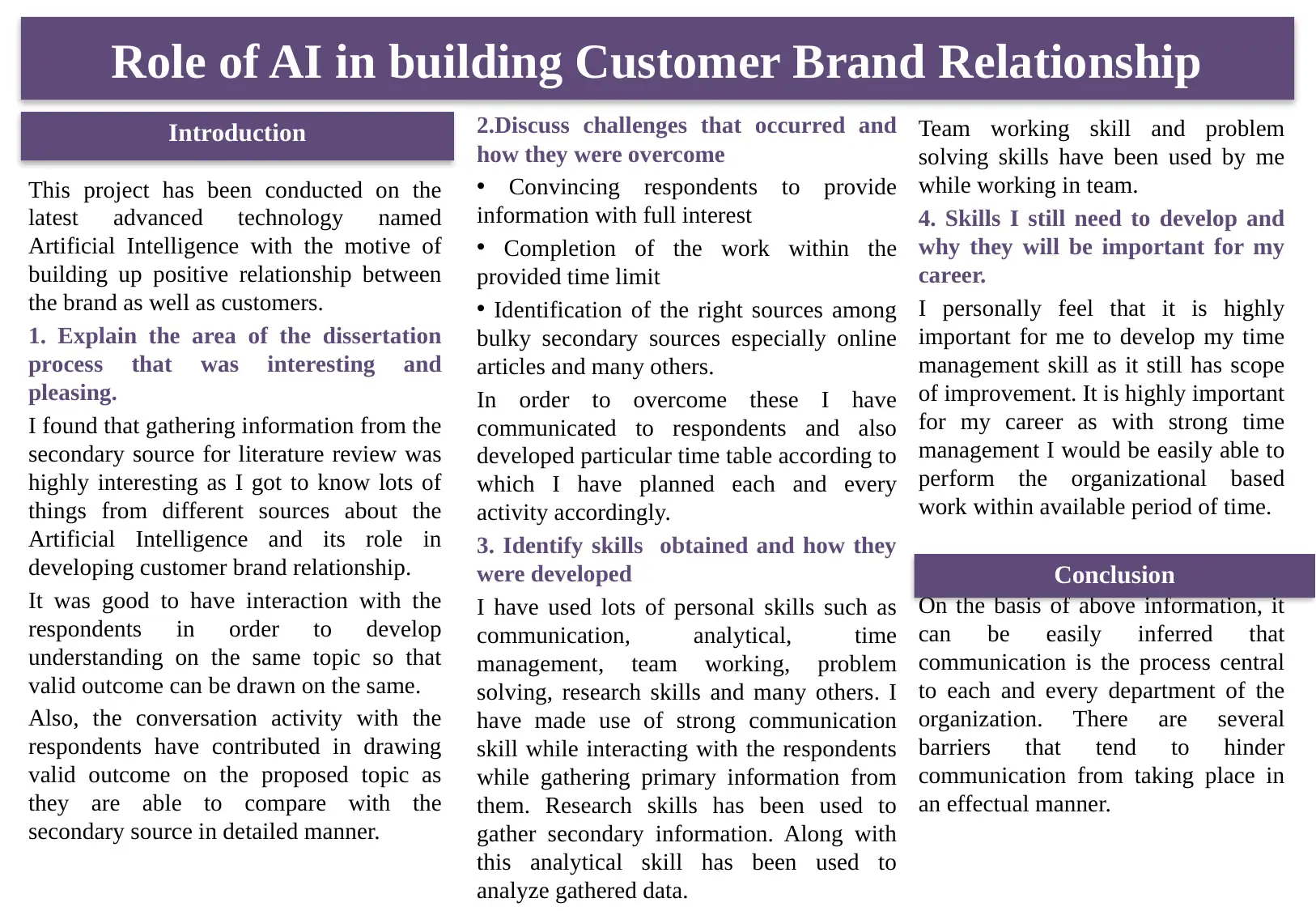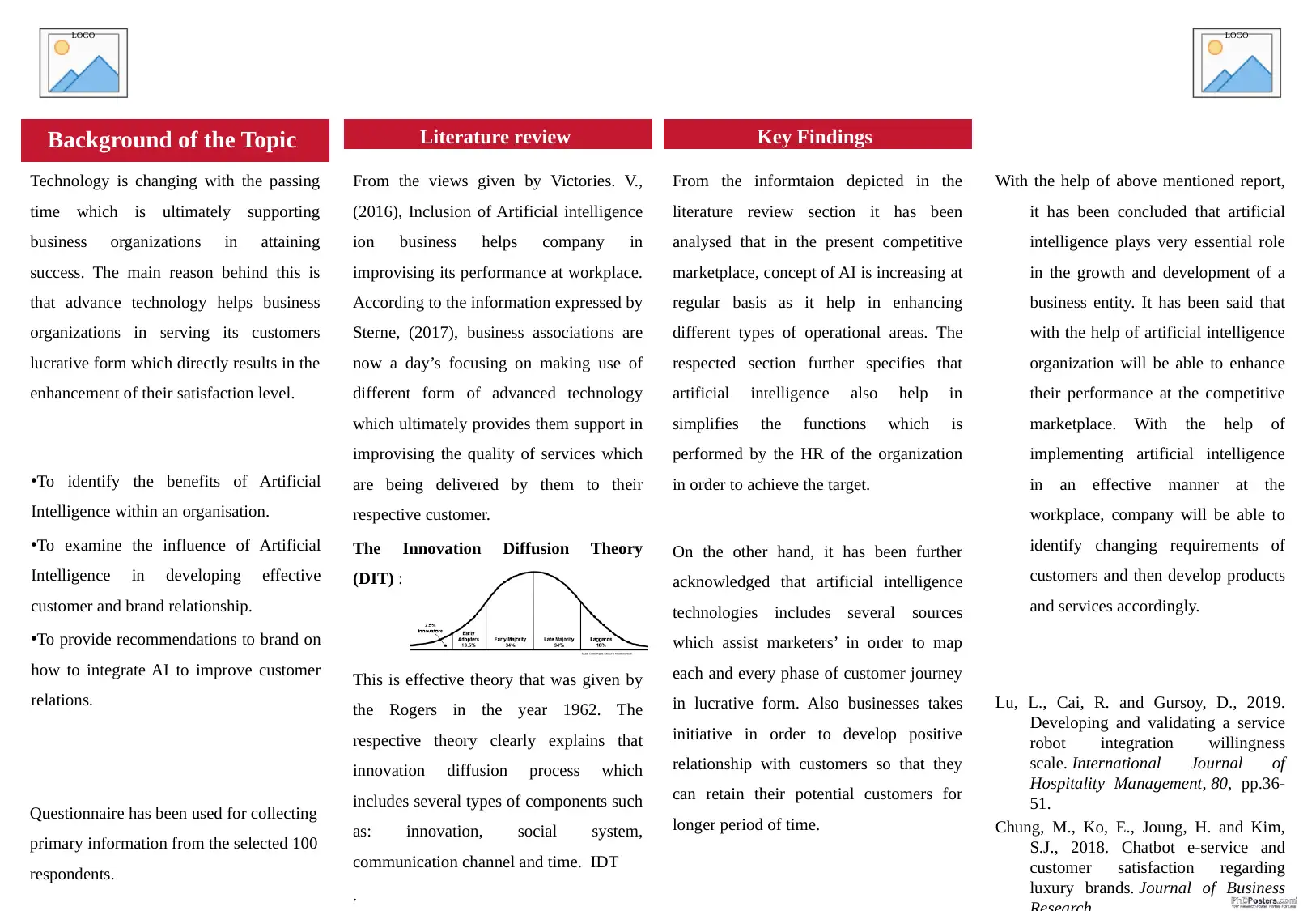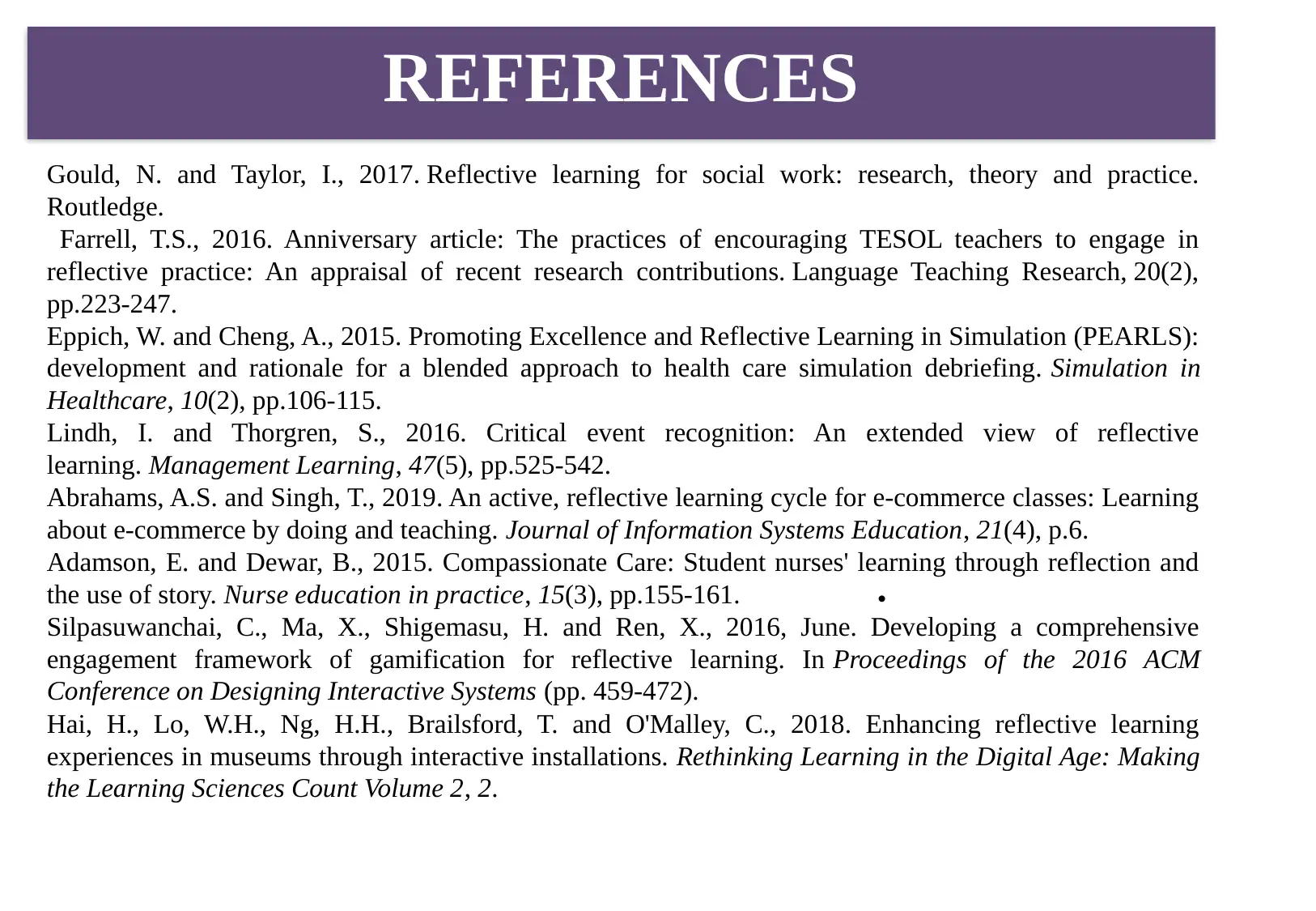Analyzing the Role of AI in Customer Brand Relationships
VerifiedAdded on 2023/01/13
|3
|1281
|47
Report
AI Summary
This report explores the critical role of Artificial Intelligence (AI) in building and enhancing customer brand relationships. The study delves into the application of AI technologies to improve customer engagement, satisfaction, and loyalty. It examines the benefits of AI in various operational areas, including identifying customer needs and personalizing services. The research includes a literature review, key findings, and analysis of challenges and skills developed during the research process. The report also discusses the Innovation Diffusion Theory and provides recommendations for integrating AI to improve customer relations. The report concludes by emphasizing the importance of communication in organizations and the impact of AI on customer and brand interactions.

Role of AI in building Customer Brand Relationship
This project has been conducted on the
latest advanced technology named
Artificial Intelligence with the motive of
building up positive relationship between
the brand as well as customers.
1. Explain the area of the dissertation
process that was interesting and
pleasing.
I found that gathering information from the
secondary source for literature review was
highly interesting as I got to know lots of
things from different sources about the
Artificial Intelligence and its role in
developing customer brand relationship.
It was good to have interaction with the
respondents in order to develop
understanding on the same topic so that
valid outcome can be drawn on the same.
Also, the conversation activity with the
respondents have contributed in drawing
valid outcome on the proposed topic as
they are able to compare with the
secondary source in detailed manner.
Team working skill and problem
solving skills have been used by me
while working in team.
4. Skills I still need to develop and
why they will be important for my
career.
I personally feel that it is highly
important for me to develop my time
management skill as it still has scope
of improvement. It is highly important
for my career as with strong time
management I would be easily able to
perform the organizational based
work within available period of time.
On the basis of above information, it
can be easily inferred that
communication is the process central
to each and every department of the
organization. There are several
barriers that tend to hinder
communication from taking place in
an effectual manner.
Introduction 2.Discuss challenges that occurred and
how they were overcome
• Convincing respondents to provide
information with full interest
• Completion of the work within the
provided time limit
• Identification of the right sources among
bulky secondary sources especially online
articles and many others.
In order to overcome these I have
communicated to respondents and also
developed particular time table according to
which I have planned each and every
activity accordingly.
3. Identify skills obtained and how they
were developed
I have used lots of personal skills such as
communication, analytical, time
management, team working, problem
solving, research skills and many others. I
have made use of strong communication
skill while interacting with the respondents
while gathering primary information from
them. Research skills has been used to
gather secondary information. Along with
this analytical skill has been used to
analyze gathered data.
Conclusion
This project has been conducted on the
latest advanced technology named
Artificial Intelligence with the motive of
building up positive relationship between
the brand as well as customers.
1. Explain the area of the dissertation
process that was interesting and
pleasing.
I found that gathering information from the
secondary source for literature review was
highly interesting as I got to know lots of
things from different sources about the
Artificial Intelligence and its role in
developing customer brand relationship.
It was good to have interaction with the
respondents in order to develop
understanding on the same topic so that
valid outcome can be drawn on the same.
Also, the conversation activity with the
respondents have contributed in drawing
valid outcome on the proposed topic as
they are able to compare with the
secondary source in detailed manner.
Team working skill and problem
solving skills have been used by me
while working in team.
4. Skills I still need to develop and
why they will be important for my
career.
I personally feel that it is highly
important for me to develop my time
management skill as it still has scope
of improvement. It is highly important
for my career as with strong time
management I would be easily able to
perform the organizational based
work within available period of time.
On the basis of above information, it
can be easily inferred that
communication is the process central
to each and every department of the
organization. There are several
barriers that tend to hinder
communication from taking place in
an effectual manner.
Introduction 2.Discuss challenges that occurred and
how they were overcome
• Convincing respondents to provide
information with full interest
• Completion of the work within the
provided time limit
• Identification of the right sources among
bulky secondary sources especially online
articles and many others.
In order to overcome these I have
communicated to respondents and also
developed particular time table according to
which I have planned each and every
activity accordingly.
3. Identify skills obtained and how they
were developed
I have used lots of personal skills such as
communication, analytical, time
management, team working, problem
solving, research skills and many others. I
have made use of strong communication
skill while interacting with the respondents
while gathering primary information from
them. Research skills has been used to
gather secondary information. Along with
this analytical skill has been used to
analyze gathered data.
Conclusion
Paraphrase This Document
Need a fresh take? Get an instant paraphrase of this document with our AI Paraphraser

Background of the Topic
Technology is changing with the passing
time which is ultimately supporting
business organizations in attaining
success. The main reason behind this is
that advance technology helps business
organizations in serving its customers
lucrative form which directly results in the
enhancement of their satisfaction level.
•To identify the benefits of Artificial
Intelligence within an organisation.
•To examine the influence of Artificial
Intelligence in developing effective
customer and brand relationship.
•To provide recommendations to brand on
how to integrate AI to improve customer
relations.
Questionnaire has been used for collecting
primary information from the selected 100
respondents.
Literature review
Lu, L., Cai, R. and Gursoy, D., 2019.
Developing and validating a service
robot integration willingness
scale. International Journal of
Hospitality Management, 80, pp.36-
51.
Chung, M., Ko, E., Joung, H. and Kim,
S.J., 2018. Chatbot e-service and
customer satisfaction regarding
luxury brands. Journal of Business
With the help of above mentioned report,
it has been concluded that artificial
intelligence plays very essential role
in the growth and development of a
business entity. It has been said that
with the help of artificial intelligence
organization will be able to enhance
their performance at the competitive
marketplace. With the help of
implementing artificial intelligence
in an effective manner at the
workplace, company will be able to
identify changing requirements of
customers and then develop products
and services accordingly.
From the views given by Victories. V.,
(2016), Inclusion of Artificial intelligence
ion business helps company in
improvising its performance at workplace.
According to the information expressed by
Sterne, (2017), business associations are
now a day’s focusing on making use of
different form of advanced technology
which ultimately provides them support in
improvising the quality of services which
are being delivered by them to their
respective customer.
The Innovation Diffusion Theory
(DIT) :
This is effective theory that was given by
the Rogers in the year 1962. The
respective theory clearly explains that
innovation diffusion process which
includes several types of components such
as: innovation, social system,
communication channel and time. IDT
.
LOGO LOGO
Key Findings
From the informtaion depicted in the
literature review section it has been
analysed that in the present competitive
marketplace, concept of AI is increasing at
regular basis as it help in enhancing
different types of operational areas. The
respected section further specifies that
artificial intelligence also help in
simplifies the functions which is
performed by the HR of the organization
in order to achieve the target.
On the other hand, it has been further
acknowledged that artificial intelligence
technologies includes several sources
which assist marketers’ in order to map
each and every phase of customer journey
in lucrative form. Also businesses takes
initiative in order to develop positive
relationship with customers so that they
can retain their potential customers for
longer period of time.
Technology is changing with the passing
time which is ultimately supporting
business organizations in attaining
success. The main reason behind this is
that advance technology helps business
organizations in serving its customers
lucrative form which directly results in the
enhancement of their satisfaction level.
•To identify the benefits of Artificial
Intelligence within an organisation.
•To examine the influence of Artificial
Intelligence in developing effective
customer and brand relationship.
•To provide recommendations to brand on
how to integrate AI to improve customer
relations.
Questionnaire has been used for collecting
primary information from the selected 100
respondents.
Literature review
Lu, L., Cai, R. and Gursoy, D., 2019.
Developing and validating a service
robot integration willingness
scale. International Journal of
Hospitality Management, 80, pp.36-
51.
Chung, M., Ko, E., Joung, H. and Kim,
S.J., 2018. Chatbot e-service and
customer satisfaction regarding
luxury brands. Journal of Business
With the help of above mentioned report,
it has been concluded that artificial
intelligence plays very essential role
in the growth and development of a
business entity. It has been said that
with the help of artificial intelligence
organization will be able to enhance
their performance at the competitive
marketplace. With the help of
implementing artificial intelligence
in an effective manner at the
workplace, company will be able to
identify changing requirements of
customers and then develop products
and services accordingly.
From the views given by Victories. V.,
(2016), Inclusion of Artificial intelligence
ion business helps company in
improvising its performance at workplace.
According to the information expressed by
Sterne, (2017), business associations are
now a day’s focusing on making use of
different form of advanced technology
which ultimately provides them support in
improvising the quality of services which
are being delivered by them to their
respective customer.
The Innovation Diffusion Theory
(DIT) :
This is effective theory that was given by
the Rogers in the year 1962. The
respective theory clearly explains that
innovation diffusion process which
includes several types of components such
as: innovation, social system,
communication channel and time. IDT
.
LOGO LOGO
Key Findings
From the informtaion depicted in the
literature review section it has been
analysed that in the present competitive
marketplace, concept of AI is increasing at
regular basis as it help in enhancing
different types of operational areas. The
respected section further specifies that
artificial intelligence also help in
simplifies the functions which is
performed by the HR of the organization
in order to achieve the target.
On the other hand, it has been further
acknowledged that artificial intelligence
technologies includes several sources
which assist marketers’ in order to map
each and every phase of customer journey
in lucrative form. Also businesses takes
initiative in order to develop positive
relationship with customers so that they
can retain their potential customers for
longer period of time.

•
REFERENCES
Gould, N. and Taylor, I., 2017. Reflective learning for social work: research, theory and practice.
Routledge.
Farrell, T.S., 2016. Anniversary article: The practices of encouraging TESOL teachers to engage in
reflective practice: An appraisal of recent research contributions. Language Teaching Research, 20(2),
pp.223-247.
Eppich, W. and Cheng, A., 2015. Promoting Excellence and Reflective Learning in Simulation (PEARLS):
development and rationale for a blended approach to health care simulation debriefing. Simulation in
Healthcare, 10(2), pp.106-115.
Lindh, I. and Thorgren, S., 2016. Critical event recognition: An extended view of reflective
learning. Management Learning, 47(5), pp.525-542.
Abrahams, A.S. and Singh, T., 2019. An active, reflective learning cycle for e-commerce classes: Learning
about e-commerce by doing and teaching. Journal of Information Systems Education, 21(4), p.6.
Adamson, E. and Dewar, B., 2015. Compassionate Care: Student nurses' learning through reflection and
the use of story. Nurse education in practice, 15(3), pp.155-161.
Silpasuwanchai, C., Ma, X., Shigemasu, H. and Ren, X., 2016, June. Developing a comprehensive
engagement framework of gamification for reflective learning. In Proceedings of the 2016 ACM
Conference on Designing Interactive Systems (pp. 459-472).
Hai, H., Lo, W.H., Ng, H.H., Brailsford, T. and O'Malley, C., 2018. Enhancing reflective learning
experiences in museums through interactive installations. Rethinking Learning in the Digital Age: Making
the Learning Sciences Count Volume 2, 2.
REFERENCES
Gould, N. and Taylor, I., 2017. Reflective learning for social work: research, theory and practice.
Routledge.
Farrell, T.S., 2016. Anniversary article: The practices of encouraging TESOL teachers to engage in
reflective practice: An appraisal of recent research contributions. Language Teaching Research, 20(2),
pp.223-247.
Eppich, W. and Cheng, A., 2015. Promoting Excellence and Reflective Learning in Simulation (PEARLS):
development and rationale for a blended approach to health care simulation debriefing. Simulation in
Healthcare, 10(2), pp.106-115.
Lindh, I. and Thorgren, S., 2016. Critical event recognition: An extended view of reflective
learning. Management Learning, 47(5), pp.525-542.
Abrahams, A.S. and Singh, T., 2019. An active, reflective learning cycle for e-commerce classes: Learning
about e-commerce by doing and teaching. Journal of Information Systems Education, 21(4), p.6.
Adamson, E. and Dewar, B., 2015. Compassionate Care: Student nurses' learning through reflection and
the use of story. Nurse education in practice, 15(3), pp.155-161.
Silpasuwanchai, C., Ma, X., Shigemasu, H. and Ren, X., 2016, June. Developing a comprehensive
engagement framework of gamification for reflective learning. In Proceedings of the 2016 ACM
Conference on Designing Interactive Systems (pp. 459-472).
Hai, H., Lo, W.H., Ng, H.H., Brailsford, T. and O'Malley, C., 2018. Enhancing reflective learning
experiences in museums through interactive installations. Rethinking Learning in the Digital Age: Making
the Learning Sciences Count Volume 2, 2.
⊘ This is a preview!⊘
Do you want full access?
Subscribe today to unlock all pages.

Trusted by 1+ million students worldwide
1 out of 3
Related Documents
Your All-in-One AI-Powered Toolkit for Academic Success.
+13062052269
info@desklib.com
Available 24*7 on WhatsApp / Email
![[object Object]](/_next/static/media/star-bottom.7253800d.svg)
Unlock your academic potential
Copyright © 2020–2025 A2Z Services. All Rights Reserved. Developed and managed by ZUCOL.





